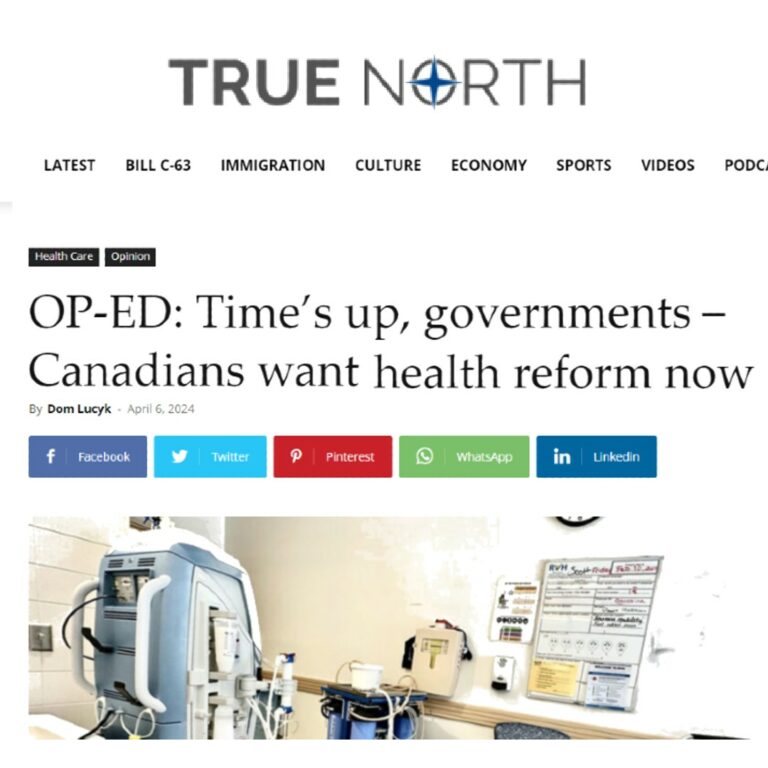TRUE NORTH COLUMN: Time’s up, governments – Canadians want health reform now

Tens of thousands of patients are dying on waitlists. Surgical wait times are through the roof. It’s getting harder to find a family doctor.
The Canadian government monopoly on health care isn’t working, and people are realizing it.
This is highlighted by new research showing Canadians know that throwing more money at our health system ‒ already one of the highest-spending in the world ‒ won’t solve the problem.
A new Leger poll commissioned by SecondStreet.org, the Montreal Economic Institute and the Canadian Constitution Foundation shows just how deep the dissatisfaction with the system runs.
A majority, 64%, believe that the Canadian health care system needs “major changes.” Another 27% think minor changes are needed, while only 5% think that throwing more money at the system will fix it.
This is a staggering number. Here’s another way to think about it: imagine you’re planning a dinner party with 100 friends. Almost all of you agree you’d like to go either to a nice steakhouse or a local burger joint, but five friends insist on a seedy fish place known for causing indigestion.
Where do you think you’d want to hold that party? If Canadian governments were in charge, they’d likely pick the fish place. They just can’t seem to stomach the idea of meaningful health reform.
The federal government continues to push misinformation around reforming the system. Health Minister Mark Holland recently went on an uninformed diatribe saying health systems that allow patients to pick private options are “an abject disaster.”
Of course, he was unable to cite any such system and ignored that every other developed country with a universal public system (most have better outcomes than Canada) allows patients to pay for care if they choose. In countries such as Sweden, most patients use the public system, but when some patients decide to pay for private care, it takes pressure off the public system.
Ottawa rejects this approach. Last year, the feds reduced funding to provincial governments that allow patients to pay for private diagnostic scans, such as MRIs, outside of the public system. Again, no other nation on earth does this.
Rather than listen to Canadians, the federal government seems dead-set on creating more problems in the system. Look at how it insists on bringing the worst parts of the current health care system to pharmacare. Despite how much Ottawa has pushed for single-payer pharmacare, a mere 3% polled listed this measure as a top priority when it comes to health reform.
Instead, Canadians’ top priorities are access to family doctors (46%), shorter wait times at emergency rooms (16%) and shorter wait times for common surgeries and other treatments (10%).
The federal government is clearly failing patients, but some provinces are at least making marginal steps towards the last item on that list. Ontario, Alberta, Saskatchewan and more have been contracting publicly-funded, privately-run clinics to perform more surgeries. This is a start, as it has been proven to help patients, but much more needs to be done.
Why don’t some provinces make a bold decision and keep our public system but allow patients to pay for private options? This is already legal in Quebec and, as mentioned earlier, the rest of the developed world. Countries like Sweden, Australia, and many others that outperform Canada all allow this option. It may lead to a political showdown, but it would help reduce wait times.
Provinces could also put patients first by copying a policy in the European Union known as the Cross-Border Directive. This policy allows all EU patients to travel to other EU countries for surgery, pay for it, then be reimbursed for up to what it would have cost the government to provide the surgery locally.
If Canada copied this policy, lower and middle income patients would especially be helped. Instead of being stuck on long waiting lists for years, they could travel to another province or perhaps to another developed country and receive surgery in weeks.
These are just a couple of common-sense ideas that could help. Whether or not they’re implemented, one thing is overwhelmingly clear. The status quo is not working, and Canadians are sick and tired of being sick without a reliable health system to take care of them.
Dom Lucyk is the Communications Director for SecondStreet.org, a Canadian think tank.
This column was published in True North on April 6, 2024.
You can help us continue to research and tell stories about this issue by making a donation or sharing this content with your friends. Be sure to sign up for our updates too!


